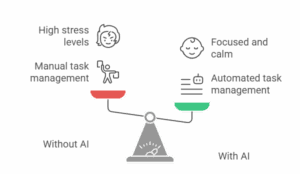What Is an AI Workflow? A Simple Guide for Busy Business Owners
You’ve heard the term. You’ve seen it in tools. But what does an AI workflow really mean for your business? This guide breaks it down in simple terms, without the tech overload.
If you want a deeper look at practical strategies, check out the full guide on smart AI workflow automation for small business success.
What Exactly Is an AI Workflow?
An AI workflow is a series of steps that a system follows to complete a task using artificial intelligence. It’s a simple form of process automation that helps you automate tasks you normally handle by hand.
It works like a checklist. You set the steps. The system runs them. You can use AI to handle emails, form submissions, task tracking, and more—without being tied to your desk. For localized, practical applications, you might be interested in AI automation tasks local businesses can do today.
Why AI Workflows Help Small Businesses Stay Efficient
Let’s say you run a local truck driving school. Each week, you send out the same reminders and update the same forms. These are the kinds of things that slow you down.
Now picture this instead. A student fills out your form. The system checks the info, adds it to your CRM, sends a welcome message, and creates a follow-up task for your team. This happens instantly through automation software.
That’s not just time saved. That’s time re-invested in growing your business.

AI transforms work into a smoother, less stressful experience.
A Day Without AI vs. A Day With It
Without AI: You check emails, copy and paste data, try to remember what you missed, and get pulled into busywork.
With AI: Your system logs the lead, sends the email, and updates your calendar. You start your day focused.
This is what happens when you begin adopting AI into everyday work. It’s smoother, cleaner, and less stressful.
Key Terms to Know (Without the Tech Jargon)
- Trigger: What starts the workflow, like a form or message
- Step: One thing the system does, such as sending an email
- Bot: A tool that handles the work (like Zapier, Make, or a ChatGPT integration)
- Automation Software: Platforms that manage your steps. Many now use AI models to improve results over time.
You don’t need to memorize these. Just start to notice where the same things happen again and again in your business.
How to Know If AI Workflows Can Help Your Business
Look at your team’s daily routines. Do these sound familiar?
- Answering the same kinds of emails
- Moving customer info between systems
- Chasing paperwork or follow-ups
These are strong signs that AI automation can help. You already have the processes. Now it’s about choosing the right automation tools to support them.
Quick Start: What to Automate First
If you’re not sure where to begin, look at what slows you down the most.
- Lead follow-up: Send a reply, log it in your CRM, and schedule a reminder
- Client onboarding: Use a form to send a welcome packet, schedule the first meeting, and confirm next steps
- Weekly reports: Pull data from tools and send a summary email to your team
Many small teams start by implementing AI in just one area. That first win gives them the confidence to expand from there. The systems grow with you.
Why Starting Simple Makes the Most Sense
Some business owners feel pressure to build something advanced right away. But most long-term wins come from starting small and scaling with confidence. Each task you automate opens the door to more improvements across your team.
Instead of focusing on the latest tech, focus on what frees up your time today. Small steps lead to big change—especially when your systems grow with you.
Want help finding your best place to start? The AI Workflow Readiness Assessment will show you where your biggest time savings are hiding and how to unlock them without adding complexity.
